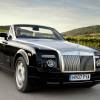
RAC sale – up to 33% off*
• Roadside cover from £5.29 a month†
• We get to most breakdowns in 60 mins or less
• Our patrols fix 4/5 breakdowns on the spot

By Jonathan Crouch
Introduction
Jaguar's XK Convertible is a high performance Grand Tourer that also aims to offer the heart and soul of a sportscar as it combines refined performance and luxury in equal measure. The gloriously melodious 5.0-litre V8 engines offer the perfect accompaniment and roof-down, you can enjoy them even more. How does it stack up as a used buy? Let's find out.
Models
2dr Convertible [5.0 V8, 5.0 Supercharged V8]
History
Think of a quintessentially British luxury convertible sportscar. The kind of classy Riviera conveyance Audrey Hepburn would have chosen. A perfect reward for a lifetime's endeavour. If you're anything like us, then this is the car that'll come to mind, Jaguar's XK Convertible.
It was first launched back in 2006 but throughout its production life, a fair degree of evolvement took place, first with the replacement of the normally aspirated and supercharged variants of the original 4.2-litre V8 with a 5.0-litre version of that unit in 2009. Then with a styling update and the introduction of a supercar-slaying XKR-S flagship version in 2012. This was all necessary, for in the later stages of this model's product cycle, the luxury sportscar market segment saw the launch of new generation versions of all three of this car's closest competitors, the Mercedes SL, the BMW 6 Series Convertible and the Porsche 911 Cabriolet.
Throughout the life of the XK, the convertible part of its appealing formula remained the same, the beautifully crafted triple-lined fabric roof raising and lowering in less than 18 seconds, disappearing into the bodywork when retracted to be concealed by a carefully crafted aluminium tonneau cover. Right up to the end of sales in early 2015, it remained one of the most beautiful cars of its kind. But how does it stack up as a used buy? Let's find out.
What You Get
Be honest: you want one don't you? You probably wouldn't be reading this otherwise. The dramatic seductively sweeping curves of the bodywork are supposed to have been inspired by those of actress Kate Winslet - according at least to stylist Ian Callum. This was his first Jaguar design and it was also the first of the brand's cars to feature the aluminium construction supposed to make this model 30% stiffer and 100kgs lighter than its XK8 predecessor. You wouldn't know this of course from looking at the shapely profile - and to be frank, you wouldn't guess the fact from looking at the stats either: this car's 1.7-tonne kerb weight makes it no lighter than a rival Mercedes SL and that car has to carry a heavy metal-folding roof.
Still, forget the facts: just revel in the contemporary fusion of power, style and uncompromised luxury which, according to Jaguar, is what we have here. It certainly looks an assured piece of work, with the oval front grille and the way the rear cabin tapers in over the haunches both classic E-Type-inspired touches. Even the front badge is a nod to that illustrious sports coupe. The car looks sinewy and muscular, the sheet metal stretched over something seriously purposeful.
Not that the whole look didn't benefit from refreshment throughout the XK model's lifetime - as you'd expect given a spell on the market that dated between 2006 and 2015. The 2012 model year wash 'n brush-up saw the adoption of slimmer front headlamps that incorporated LED signal functions and running lights. Combined with a larger grille and a sleeker bumper design, this all gave the XK a bit more 'rear view mirror' recognition.
XKR-specific bits include a more aggressive colour-keyed front bumper that, if not quite as extreme as the one you get on an XKR-S, is certainly menacing enough to scatter fast lane dawdlers as you bear down upon them, incorporating tall air intakes on each side that complement potent side power vents and old-school bonnet louvers. As you walk round the car, you glimpse 'R'-logo-ed brake callipers peeping out through enormous 20-inch 'SUPERCHARGER'-branded alloy wheels, while below the LED lamps at the back, the post-2011 XKR models feature a revised lower valance.
Opt for a Convertible XK or XKR and you'll find that like Porsche and BMW - but unlike Mercedes - Jaguar has opted for a fabric roof, the triple-layered hood rising or falling in under 18seconds and slotting neatly beneath an aluminium tonneau cover when not in use. You'd expect the rag top approach to facilitate a larger boot than would be possible on a metal folding topped rival like Mercedes' MK6 SL. In fact, the XK lags a little behind the 364-litres available from its Stuttgart competitor. Still at least the 313-litres you get from the XK Convertible is only 17-litres less than you'd get from the Coupe. And that's almost three times what you'd get from a Porsche 911 Cabriolet from this era, enough to make the difference between pleasant packing into conventional suitcases for a weekend break and uncomfortable cramming of your designer clothes into squashy bags.
Inside the wonderful snug yet spacious leather and alcantara-clad cabin, owners of earlier XK models will notice that the fit, finish and choice of materials of the post-2011 version is noticeably more up-market - once they've adjusted to the replacement of the original XK's J-gate auto gear lever with a neat rotary JaguarDrive Selector. It rises up into the palm of your hand after you press a Start button that pulses red on the centre console while around you, the dashboard illuminates and the cabin features are highlighted in a cool phosphor blue.
At the same time, the 7-inch colour touchscreen that dominates the centre of the dash lights up, controlling satellite navigation, climate control, Bluetooth 'phone functionality and in-car audio. Around it, dark wood veneer and aluminium trim supply the necessary sporting ambience and electric adjustment of both seat and steering wheel mean it's easy to find the ideal driving position. Behind you, all models offer a couple of occasional small child-orientated seats that'll doubtless be more usually be used for the carriage of designer jackets or shopping bags.
What You Pay
Please fill in the form here for an exact up-to-date information.
What to Look For
Early XKs had their share of niggling faults but by the time production reached the post-2011 models we'd recommend you look at, the company had ironed out most of the issues. Most of the issues reported concern suspension issues - and there are a few reports of electrical issues that can prove costly to fix. A few gearbox and clutch issues have been reported too. Make sure that the big alloy wheels haven't been unduly kerbed too.
Otherwise, the usual cautions still apply: stick to main dealers or reputable specialists and don't be tempted by a potential bargain car that doesn't have its service history present and correct, especially the supercharged XKR which can suffer cooling problems if subjected to hard track use.
Replacement Parts
(approx - based on a 2013 XK Convertible 5.0 V8) At dealers, parts are inevitably quite pricey. As a rough guide, a full exhaust system (without catalyst) is just under £600. Front shock absorbers are about £110 a pair. An alternator is about £300 and a starter motor around £300. Shop around a bit though and you can find cheaper prices; we found a brake disc at around £85, a water pump at £74, an oil filter at £26 and an air conditioning condenser at £95.
On the Road
On paper, there's no real dynamic reason why a Jaguar XK can't be one of the tautest, most responsive performance sportscars out there. It has a very stiff, modern chassis, a powerful engine and a quick-witted 6-speed automatic gearbox with slick wheel-mounted paddle shifters. You wouldn't have thought it a huge step from here to Porsche perfection. Yet the XK never quite managed it. Press the gently heartbeat-throbbing engine starter button and first impressions are good though, as the lovely JaguarDrive rotary selector glides slowly up into the palm of your hand and the 5.0-litre V8 growls into life before settling back into a loud but contended purr. You're ready.
If you're in a normally aspirated XK Convertible, the 380bhp 5.0-litre V8 that'll beat beneath the bonnet will wallop the car to 62mph in just 5.5s and on to a limited top speed of 155mph. This is a glorious engine, ever-eager to rev with a wonderful burble that becomes an almost angry snarl as you ascend the rev range. Switch the rotary selector into manual mode and the exhaust even pops and crackles as you go down the standard 6-speed automatic gearbox using the tactile steering wheel-mounted paddles.
If you're fortunate enough to be driving a supercharged XKR model, you don't have to travel very far before you understand one thing very clearly: this is a very fast car indeed. The 5.0-litre V8 it uses may be essentially the same as that of the standard version but the addition of a supercharger to this unit is enough for ballistic performance. Even a gradual stroke of your right foot is enough to see quite a number of the 503 available braked horses make a break for freedom, such is the low-down torque of this engine, its peak on offer from as little as 2,500rpm, at which point you're starting to fully appreciate the multi-layered pulsing V8 bellow with its accompanying but unobtrusive supercharging scream. Sixty two mph from rest flashes by unnoticed in just 4.8s, less than a second and a half slower than the Porsche 911 Turbo that would cost you £40,000 more. But the really telling increment is the 50-70mph overtaking one, demolished in under two seconds. The 25% improvement this represents over what you'd get in an ordinary XK might not sound much but on the road, it's the difference between picking off one overtaking victim or a whole queue of them.
Flat out with the nannying 155mph speed limiter removed, this would be a 190mph car - as indeed it is in its ultimate 542bhp XRS-S guise, this the fastest and most powerful sportscar Jaguar has ever produced. If ever you were tempted to wonder just how much of a supercar a Jaguar XK could be with extra-power, sharper handling, more extreme looks and an exclusive Ferrari-style interior, then wonder no more: this is that car. This flagship version's appeal doesn't shine out too brightly from the balance sheet - the 4.4s 0-62mph figure is, after all, just 0.4s faster than that of an XKR - but that's because its appeal is more tactile, rawer and more emotional, as it needed to be. Many will think the louder, crisper engine note worth the price of admission all on its own - though your neighbours may not agree. More importantly, the handling created the closest thing to a Porsche 911 that potential buyers back in 2013 had yet seen with an XK badge, thanks to much sharper steering, reprogrammed damper and differential controls, wider tyres and lighter wheels. The XKR-S spring rates were also 28% stiffer though fortunately, this doesn't seem to be enough to completely spoil the supple high speed ride.
The ride, in fact, is the thing that sets any XK from its German rivals and this was further enhanced in the second half of the XK's production run by the adoption of what Jaguar called 'Adaptive Dynamics'. It's a system that continually monitors steering response, brake input, wheel position, body motion and throttle settings, then, millisecond by millisecond, adapts the Bilstein dampers to suit. It's far better than the original XK model's rather crude selectable 'soft' or 'hard' damping system, 'Adaptive Dynamics' able to automatically choosing the right set-up for the mood you're in and the road you're on. Put simply, it's a confidence thing: with this improved set-up, the car always feels as if it's working with you. Which is nice to have when you've the kind of power under your right foot that F1 drivers used to have back in the mid-Seventies.
If you want to stay permanently in red mist mode, pressing a centre console chequered flag-logo-ed 'Dynamic' button will not only keep the suspension firm and the gearchanges quick but also let the engine sing more lustily as the exhaust silencers are bypassed. Brilliant. Go a step further and select 'TracDSC' - one of four modes in the Dynamic Stability Control set-up - and you really need to be on a racetrack, for here there's enough slip allowed for you to hang the back out, though with a helpful safety net built in should your enthusiasm exceed your talent. If this Jaguar could only have replicated its Porsche rival's pin-sharp steering, then it could have got itself right on the 911's tail.
In an XKR, in doing all of this, you'll appreciate another great handling aid: Active Differential Control. It's there to generate extra traction on all kinds of surfaces in all kinds of conditions, but you notice it most the first time that you throw this Jaguar into a corner. That's when the system can instantly divert torque to the outside rear wheel to stop the tail beginning to slide. So the car always feels planted, shifting its weight through the corners with the lithe confidence of a world class downhill skier. It all further emphasises that feeling we were talking about of complete control, complete confidence in its abilities. The faster you go, the better it feels.
Especially if you're in a Convertible model. The noise any XK makes is one of its biggest selling points and being able to drop the roof down and get a little more exposure to the angry bark the V8 engine delivers only makes the open top version's appeal all the greater. The Coventry engineers behind the XK's design emphasised that this Jaguar was designed right from the outset in Convertible form, so body rigidity is very little affected by the roofless stance. Something you can convert to either stationary or at low speeds in less than 18 seconds, the triple-layered fabric top disappearing into the bodywork when retracted to be concealed by a neat aluminium tonneau cover.
Overall
The XK Convertible must be almost all things to almost all luxury sportscar buyers. A cosseting Grand Tourer in its standard guise. An out-and-out sportscar in top XKR-S form. And a ballistically quick combination of both in desirable XKR guise. As a used buy, it's also one of the most affordable cars of its kind - and its reliability record is actually very good.
It might be a touch disappointing that the supposedly lightweight aluminium underpinnings don't produce the actually lightweight result that would allow this car to fully replicate the dynamism of, say, a rival Porsche 911 Cabriolet. But Jaguar developed its F-TYPE sportscar to do that. And anyway, XK compensation comes in the form of ride and refinement better than any 911 can dream of. Better than any rival SL or 6 Series come to that.
Which leaves us - with what? The kind of car that enthusiasts will cherish years from now. An emotive British convertible sportscar that rewards, refines and relaxes your automotive life. German rivals may out-point it on paper - but on your driveway? You decide. For many, there's still nothing quite like an XK. Especially when it's a Convertible.







